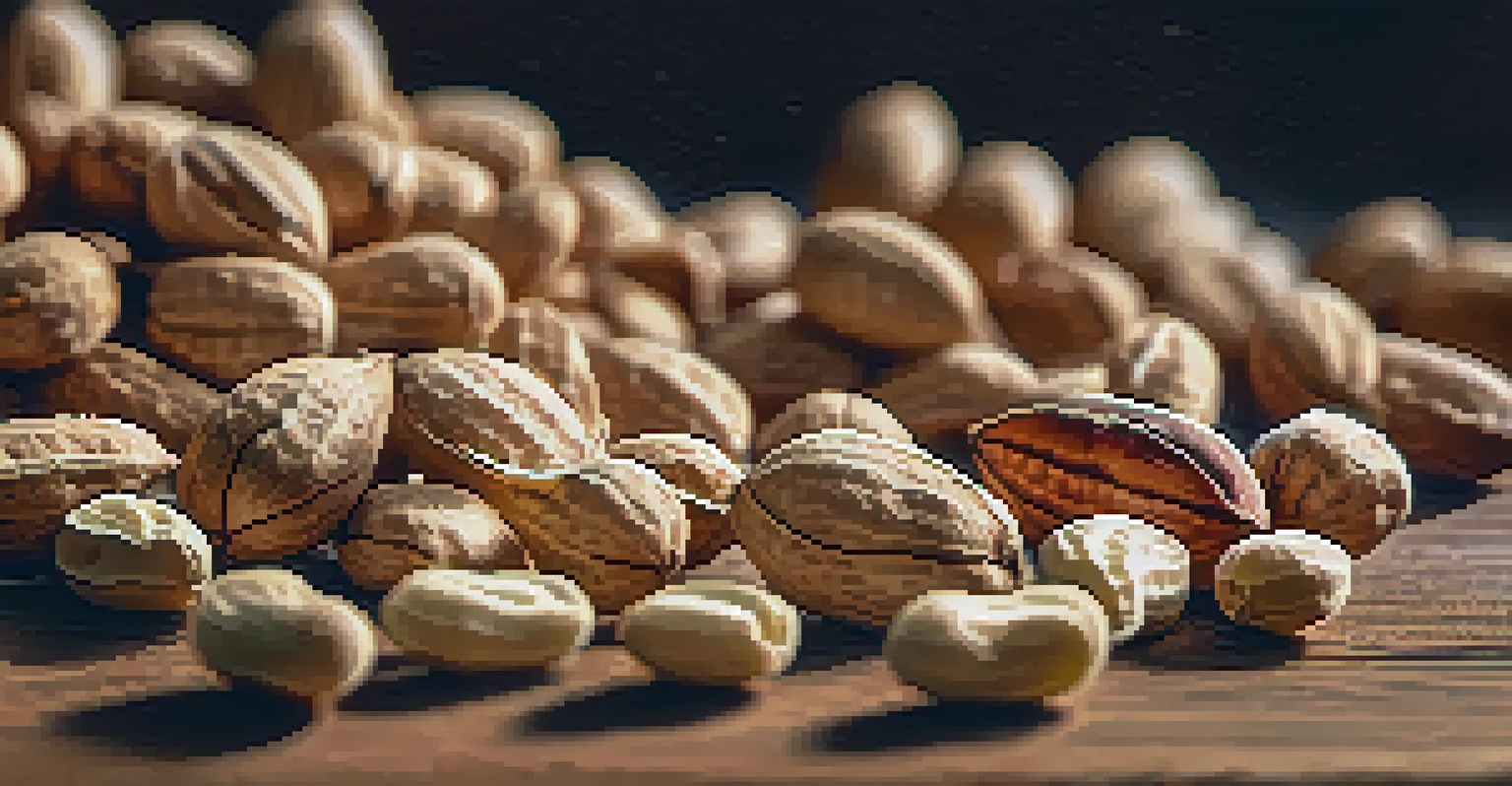Georgia's Agricultural Exports: Key Markets and Trends

Overview of Georgia's Agricultural Export Landscape
Georgia plays a pivotal role in the agricultural sector, being one of the top states for agricultural exports in the U.S. The state's diverse climate allows for a wide range of crops and livestock, making it a vital contributor to the national economy. In recent years, Georgia's agricultural exports have seen substantial growth, driven by both domestic demand and international markets.
Agriculture is the most healthful, most useful and most noble employment of man.
In 2022, Georgia's agricultural exports were valued at over $4 billion, showcasing the strength and resilience of its farming community. Key products include poultry, peanuts, cotton, and pecans, each contributing significantly to the state's export figures. The state's strategic location, with access to major transportation routes, further enhances its export capabilities.
As we delve deeper into Georgia's agricultural exports, it's essential to understand the key markets that drive this growth and the emerging trends that shape the industry. By analyzing these factors, we can better appreciate how Georgia's agricultural landscape is evolving and what the future may hold.
Top Agricultural Exports from Georgia
Georgia is renowned for its variety of agricultural products, with poultry leading the pack as the state's top export. The state's climate and expertise in poultry farming have positioned it as a national leader, supplying not only domestic markets but also exporting to numerous countries worldwide. This success has helped bolster jobs and revenue within the state.

Peanuts, another signature crop, also play a crucial role in Georgia's agricultural exports. The state accounts for nearly half of all peanut production in the United States, making it a key player in the global peanut market. The versatility of peanuts—from snacks to cooking oils—ensures a consistent demand both locally and abroad.
Georgia's Exports Surpass $4 Billion
In 2022, Georgia's agricultural exports were valued at over $4 billion, highlighting the state's significant contribution to the national economy.
Cotton, often referred to as 'king cotton,' remains a staple export as well. Georgia's fertile soil and ideal growing conditions allow for high-quality cotton production, which is sought after in various international markets. Each of these products not only contributes to economic stability but also reflects the agricultural heritage of Georgia.
Key Export Markets for Georgia's Agriculture
When it comes to export markets, Canada and Mexico are among Georgia's largest trading partners. The proximity and trade agreements between these countries facilitate a high volume of agricultural goods flowing across borders. These relationships have grown stronger over the years, contributing to a thriving export market for Georgia's farmers.
The future of agriculture is not about how much we produce, but how sustainably we produce it.
In addition to North America, Asia represents a significant and growing market for Georgia's agricultural exports. Countries like China and Japan are increasingly importing Georgia's poultry and peanuts, driven by rising consumer demand for quality products. This shift towards Asian markets highlights the importance of adaptability in Georgia's agricultural sector.
Moreover, the European Union has emerged as a key player in Georgia's export landscape. With stringent quality standards, Georgia's farmers are rising to the challenge, ensuring their products meet international criteria. This commitment to quality not only opens new avenues for exports but also strengthens Georgia's reputation globally.
Emerging Trends in Georgia's Agricultural Exports
Sustainability is becoming a vital trend influencing Georgia's agricultural exports. Consumers are increasingly seeking products that are environmentally friendly and ethically produced. As a result, many farmers are adopting sustainable practices, which not only benefit the environment but also appeal to conscientious consumers in international markets.
Technological advancements are also reshaping the agricultural landscape in Georgia. From precision agriculture to improved supply chain logistics, technology is enhancing productivity and efficiency. These innovations enable farmers to meet the demands of global markets more effectively, ensuring they remain competitive.
Key Markets Include North America
Canada and Mexico are among Georgia's largest trading partners, bolstered by trade agreements that facilitate the flow of agricultural goods.
Furthermore, the rise of organic farming is noteworthy. As health-conscious consumers look for organic produce, Georgia farmers are responding by expanding their organic offerings. This trend not only caters to a niche market but also reflects a broader shift towards healthier eating habits among consumers worldwide.
Impact of Trade Policies on Agricultural Exports
Trade policies significantly influence Georgia's agricultural exports, shaping the landscape in which farmers operate. For instance, trade agreements like USMCA (United States-Mexico-Canada Agreement) have streamlined trade processes, benefiting Georgia's producers. These agreements help reduce tariffs and barriers, making it easier for Georgia's products to reach international markets.
On the flip side, trade disputes or tariffs can pose challenges for exporters. Fluctuating trade relations can impact market access and pricing, creating uncertainty for farmers. Staying informed about these changes is crucial for Georgia's agricultural community to navigate the complexities of global trade effectively.
In light of these dynamics, it's essential for Georgia's farmers to engage with policymakers to advocate for favorable trade conditions. Understanding and influencing trade policies can help ensure the continued growth of agricultural exports, allowing Georgia's farmers to thrive in a competitive marketplace.
Challenges Facing Georgia's Agricultural Export Sector
Despite the successes, Georgia's agricultural export sector faces several challenges. Weather-related issues, such as droughts or hurricanes, can severely impact crop yields, affecting the availability of products for export. These unpredictable weather patterns underscore the need for resilience and adaptability within the farming community.
Additionally, labor shortages pose a significant hurdle for Georgia's agricultural industry. As the demand for exports grows, so does the need for a reliable workforce. Addressing labor shortages through policy changes and workforce development initiatives is crucial to sustaining the agricultural sector's growth.
Sustainability Drives Future Growth
The rising consumer demand for environmentally friendly products is prompting Georgia's farmers to adopt sustainable practices, enhancing their global competitiveness.
Lastly, the global competition is fierce. As other countries ramp up their agricultural production, Georgia must continuously innovate and improve its practices to remain competitive. This calls for investment in research, technology, and training to ensure that Georgia's farmers can meet the demands of an increasingly globalized market.
The Future of Georgia's Agricultural Exports
Looking ahead, the future of Georgia's agricultural exports appears promising, with several factors driving growth. Continued investment in technology and sustainable practices is likely to enhance productivity and efficiency. As consumers become more conscious of sustainability, Georgia's commitment to these practices will bolster its reputation in the global market.
Moreover, expanding into new markets presents a significant opportunity. As emerging economies grow, so does the demand for high-quality agricultural products. Georgia's farmers are well-positioned to capitalize on this trend, provided they remain adaptable and responsive to market needs.

Ultimately, the resilience and innovation of Georgia's agricultural sector will play a crucial role in determining its export trajectory. By addressing challenges and embracing opportunities, Georgia can continue to thrive as a leader in agricultural exports, ensuring a bright future for its farming community.